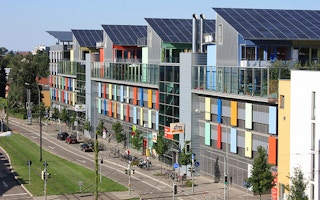The concept of green cities has evolved to encompass inclusivity and citizen well-being in addition to environmental sustainability. As more and more cities go “green”, issues such as engaging the community and affordability of housing and office space have emerged as key areas to address.
Early eco-cities tended to be developed using a “top-down approach” and built based on master plans, said Dr Thomas Schroepfer, Associate Professor and Associate Head of Pillar, Architecture and Sustainable Design at the Singapore University of Technology and Design. He presented an analysis of five eco-cities that were conceived in Europe in the early to mid-1990s to delegates on Wednesday at the three-day International Green Building conference.
Speaking at a plenary discussion at Singapore’s Marina Bay Sands Convention Centre, Schroepfer said one exception was the city of Vauban in Freiburg, Germany, where citizens could generate their own building design plans.
An extensive public participation process - including regular workshops and public dialogues - during the planning of Vauban gave citizens a say in what their city would look like.
Among their main concerns was the reduction of car usage in favour of good public transportation and walking. Vauban was thus designed with two parking garages located on the periphery of the development.
Car-owning citizens agreed to buy one parking lot and walk from the garages to their apartments through city streets that have become “playgrounds for children, and where neighbours can chat and interact”, said Dr Schroepfer.
Designing such pedestrian-friendly cities, which also helps to improve people’s health, is a strategy that resonated with Gary Lawrence, the vice president and chief sustainability officer of AECOM, a global provider of professional technical and management support.
“Heart disease and stroke are the leading causes of adult death worldwide, and they are directly correlated to obesity,” he said.
Yet, in many cities, the existing “urban forms” often reduce the need to walk. In the process of improving the quality of public transportation, Lawrence observed that “we might be reducing the wellness of the community by not providing inducements to walk and exercise.”
For cities that want to become more inclusive, one of the solutions he offered is designing parking structures such that they are “not end-points but the center of community activity, where people can store their bicycles, grow food, do recreational activities”.
Such parking structures can also take on central roles in mobility by seamlessly connecting people to bicycle paths, trams or trains so that they can continue their journeys.
“
Business communities do not like urban trees because they block advertising and take away parking spaces. But trees are the most important part of any sophisticated surface water management system because the leaves actually meter the flow of water so that smaller and fewer cisterns are needed. Trees save a lot of money.
Gary Lawrence, AECOM
Not all urban solutions require innovative design. Instead, some simple solutions require engaging the community effectively and showing them that what might seem like an opportunity cost can actually bring value in other ways. One such solution is urban trees.
Lawrence explained, “Business communities do not like urban trees because they block advertising and take away parking spaces. But trees are the most important part of any sophisticated surface water management system because the leaves actually meter the flow of water so that smaller and fewer cisterns are needed. Trees save a lot of money.”
He emphasised that any urban solution to help create more resilient cities will have to take the vulnerable populations of the city into consideration. He highlighted the fact that in all societies, older people are usually among the poorest and that by 2050, 22 per cent of the global population will be older than 60 years old.
Reducing social vulnerability is also one of the objectives of the new development master plan for the city of Sao Paulo, Brazil.
Felipe Goncalves, special advisor to the secretariat of planning, budget and management within the Mayor’s office in Sao Paulo, said there will be a 20 per cent increase in social housing for low-income residents in the newly-zoned areas of the city. Another measure that will be introduced is the “solidarity quota”, which states that for every private housing development built, a social housing development will have to be built as well.
New public transportation lines and non-residential buildings for commercial purposes have been planned in hopes of creating jobs outside of the city’s central districts. Goncalves said, “We still need a lot of public investment as we won’t be able to do all of these things with just the city budget.
Echoing this view, Schroepfer pointed out that many eco-city projects are currently subsidised by governments. He said that of the five eco-cities studied, the only one that was not heavily-subsidised was Vauban, where citizens participated in all aspects of the city planning and design, and he wondered aloud, “Could it be because it was more bottom-up?
He continued, “Future eco-cities need to create a more positive correlation between affordability and innovation. If we don’t find a different way to approach such projects, they might remain in the realm of high-end housing, and that is certainly not the role of sustainable development.
Eco-Business.com’s special event coverage of the International Green Building Conference 2013 is brought to you by City Developments Limited (CDL).













